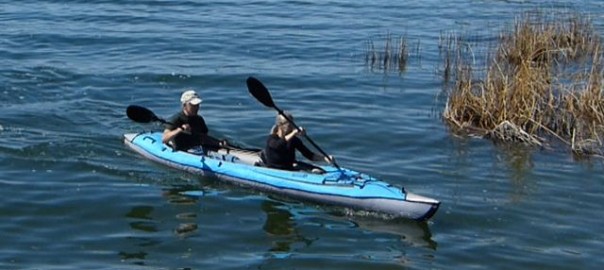So you’ve made the decision on an inflatable kayak. You’ve researched yourself to death, and have finally narrowed it down to the one that’s perfect for you. A sigh of relief – the hard part is over – until you find there are just as many choices, styles and incomprehensible terminologies for breakdown paddles.
Paddle lengths, materials, paddling styles, techniques – where to start?
Assuming that portability is the highest priority, AirKayaks has partnered with Accent and Cannon Paddles to help demystify the process of choosing a breakdown (or take-down) kayak paddle.
First of all, what is a breakdown kayak paddle?
Unlike a canoe paddle, which has one blade, shaft and handle grip, a kayak paddle features two blade heads (left hand and right hand) and a shaft.
The paddler grips the shaft with both hands, and dips one blade into the water and pulls, then dips the other side into the water and pulls. This is a more efficient method of paddling when sitting lower in the water.
While there are 2-pc breakdown paddles on the market, the most portable paddles are the 4-pc breakdown paddles consisting of two shaft lengths that connect into one, and two blades – a left hand and right hand – that attach onto the shaft. 4-pc breakdown paddles for inflatables typically have a longest shaft length of 25 to 30 inches in length, making them easily storable, often in the kayak carrying case.
What length should I look for?
Since inflatable kayaks are typically wider than hardshell kayaks, a 230 or 240cm paddle is considered a good length. For those confused with the measurement system, a 230cm paddle is 90.55 inches in length while a 240cm paddle is 94.5 inches in length (2.54 cm per inch).
The choice of either is a personal preference, but you should consider your height, paddling style and typical paddling conditions. In general, 230cm is good for persons under 6 feet, high-angle paddlers, and those in fast moving paddling conditions. Paddlers over 6 feet, low-angle paddlers and those in calmer touring conditions may be more comfortable with a 240cm, though our largest-selling paddle for inflatable kayaks is the 230cm size.
What is low and high angle paddling?
Low angle paddling keeps the blade more horizontal and can be less fatiguing.
It is often used for long-range touring, to save energy, in calmer waters and in wider kayaks.
With high angle paddling, the kayaker is lifting the blade up more perpendicular to the kayak.
This uses up more energy, but there is more power in each stroke, propelling one faster, making one more maneuverable and getting a solid workout. It is more aggressive but much more fatiguing.
Which material should I choose?
Our breakdown paddles are typically constructed of aluminum, fiberglass, carbon or a carbon
